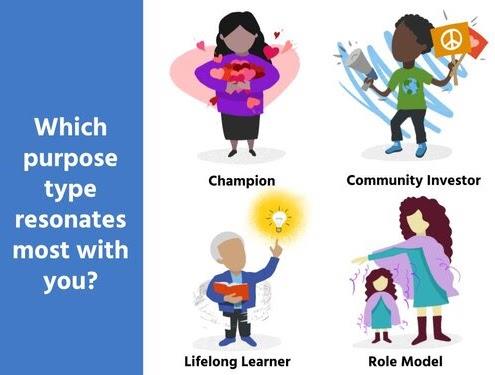- TeachPVD
- Following Your Purpose
-

Following Your PurposeTeaching is more than just a job, it’s a career that connects us to our personal why’s.
We all came to education to satisfy a deeper need -- a sense of purpose. Often, this purpose is connected to our personal journey, our experiences and identities and how they intersect. Ultimately, this purpose manifests in our teaching and how we interact with students. Through better understanding our purpose, we can channel its power into helping our students develop into the successful people they are capable of.

TEACHER PURPOSES QUIZ
What’s your purpose?
Through our research, four core purposes have emerged. Of course, this doesn’t mean that everyone fits neatly into one purpose; we each reflect intersectional reasons for doing this work.
Teacher Purpose Profiles
-

THE CHAMPION
You've always been drawn to working with kids.“People will forget the things you do, and people will forget the things you say. But people will never forget how you made them feel.” - Maya Angelou, author/poet
You teach because you love spending your day helping kids learn. You want your students to know and understand themselves and their strengths, and to feel accepted and loved because of them.
You value: trust, candor, purpose, connection, respect
Champions does their best work by building meaningful relationships with their students. Here are a couple ways that you can come to know your students -- and help them to know you too.
-
Learn the names and faces of all of your students by the end of week one. Talk to their previous teachers, connect with their families, and give them "get-to-know-you" surveys.
-
Give students easy ways to share about themselves with you. For example, ask them to draw or write a recipe for their favorite food or have them pick from a few strengths to tell you what they're awesome at. And give them permission to ask you questions too.
-
Go to your student's sports games, performances, and out-of-school events to develop a strong relationship independent of grades. When your students see you outside of the classroom, they identify you as a person before they see you as their educator.
-
-

THE COMMUNITY INVESTOR
Teaching is a way that you can contribute to the change you want to see in our society.
"My commitment to engaged pedagogy is an expression of political activism." - bell hooks, author and activist
You believe teaching is a social justice tradition. You want your students to learn about and celebrate their cultures and communities, and to understand that they can affect these.
You value: voice, community, courage, integrity, trust
Community Investors thrive on a healthy, vibrant community and building relationships through civic consciousness. You can foster the robust class community you seek and reaffirm your connections to the broader school and local community in many ways.
-
Families and caregivers are central to your students' community. Proactively connect with them early to get to know them, their needs, and the supports they already provide their child. This will help you sustain a productive relationship with them and better serve your students' needs throughout the year.
-
Connect with your entire school community by greeting all members of school staff including custodial, lunchroom and school partners. Demonstrating this level of respect for your community inspires your students to do the same.
-
Start a class blog, social media account, or newsletter. This will help to connect your students and their families as well as serve as a platform to highlight events in your community or as a place to organize for social change.
-
-

THE LIFELONG LEARNER
You teach because you love to learn.
"By learning you will teach, and by teaching you will learn." - Latin proverb
Learning never ends and teaching allows you to continuously deepen your understanding of your content area. After all, to teach something well, you must know it inside and out and be creative about how you demonstrate that. You want your students to really connect with the content, not just as a passive participant but an active contributor to the lesson.
You value: respect, enthusiasm, determination, passion
Lifelong Learners are always eager for ways they can deepen their own knowledge, insight, and practice. You can impart this hunger for knowledge on your students through creative lesson plans and actively including student voice.
-
Invite students to pick a topic or subject that interests them to teach to the class. Through this process, they can develop research and public speaking skills as well as an ownership of their learning. You will not only learn more about your students, but also several new topics to spark your inquisitive spirit.
-
Work with your colleagues to dive deeply into curriculum and consider Gholdy Muhammad's 5 pursuits: identity, skills, intellectualism, criticality, and joy. Together you can ensure that your lessons are not only interesting to you but are also culturally responsive to the needs and identities of your students. Whether you are teaching science, math, or language arts, you can incorporate your identity and passions as well as those of your students.
-
-

THE ROLE MODEL
You teach because it is a way that you can benefit kids like you."Everyone who remembers [their] own education remembers teachers, not methods and techniques. The teacher is the heart of the educational system." – Sidney Hook, philosopher
Our students deserve mirrors that reflect who they are, where they have been, and where they can go. You share similarities with your students, so it's important to you to show up in the ways that people may not have in the past. You want the kids you teach to see people who look like them thriving, learning, and supporting them in their own journeys.
You value: voice, identity, resilience, representation, joy
Role Models value their students’ identities and seek to reflect these throughout their classroom and instruction. Here are some low-hanging ways that you can demonstrate that you see and value the many identities in your classroom.
-
Where you are is a reflection of who you are. Decorate your classroom in a way that reflects your identity and the identities of your students. You will all feel most comfortable when you are in your element. You can even make it a mini lesson!
-
Be sure to read books and resources that will grab your students’ attention and show them that the world of writing can represent some parts of their own experiences. Here is a list of great examples for elementary school students.
-

